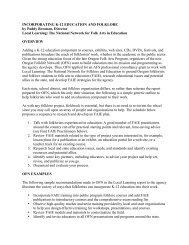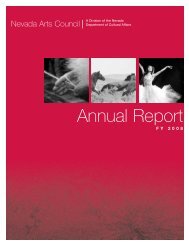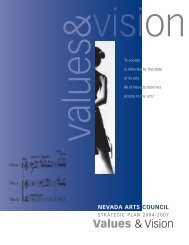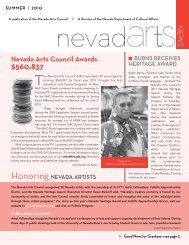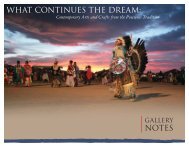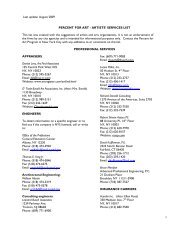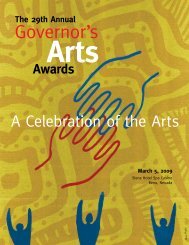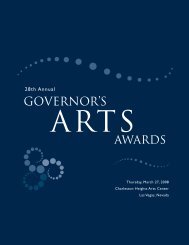Handed Down - Nevada Arts Council
Handed Down - Nevada Arts Council
Handed Down - Nevada Arts Council
Create successful ePaper yourself
Turn your PDF publications into a flip-book with our unique Google optimized e-Paper software.
1994–1995<br />
Shoshone Baskets:<br />
Lilly Sanchez and Virginia Sanchez<br />
Surrounded by bundles of fragrant willow branches,<br />
woven cradleboards and winnowing trays, Virginia<br />
Sanchez perches on the edge of her mother Lilly’s<br />
sofa, twining split willow threads around long willows<br />
splayed out in a cone shape. Virginia is working on her<br />
second project, a small cone basket used for gathering<br />
pine nut cones, and Lilly provides encouragement and<br />
advice as she adds in willows to widen the shape, or<br />
needs to splice in a new thread.<br />
Lilly Sanchez was born on what is now the Duckwater<br />
Reservation, southwest of Ely, and was raised speaking<br />
the Shoshone language and helping her grandmother<br />
gather willows for baskets. Because she moved<br />
to Carson City when her children were young, Lilly<br />
didn’t have a chance to learn basketry herself until about<br />
20 years ago when her kids were grown and her mother<br />
could teach her to weave. Now living in Fallon, it is her<br />
turn to pass her knowledge on to her own daughter,<br />
Virginia, who in turn was inspired by the birth of her<br />
daughter in 1994. “It’s kind of a responsibility, I think,<br />
that we all have,” Virginia explains. “Especially when<br />
you have children, the responsibility then is to pass it on<br />
to them. For me to be able to learn this well and then<br />
teach her is real important to me.”<br />
Like all basket making apprentices, Virginia says<br />
learning to split willows to make threads for sewing is<br />
the hardest task. “To get this string here, you’ve got to<br />
split it three ways. And once you have the willow split<br />
into thirds, then you take that willow and you take the<br />
core out of the center, and it’s coring it that’s the hardest,<br />
because it’s all by feel and pressure. And then this is<br />
the fun part here, the weaving.”<br />
Because the willows are held in the mouth during<br />
splitting, the increasing use of pesticides is a major concern<br />
for traditional weavers. Lilly tells a story of gathering<br />
willows near the prison in Carson City, but when<br />
she started splitting them her mouth went numb and<br />
she realized they had been sprayed. Virginia works as<br />
the director of Native American programs for Citizen<br />
Alert, an activist and environmental organization, and<br />
sees clearly the interaction between traditional culture<br />
and the health of the environment. “It’s simple. We’re<br />
not doing what we’re supposed to do, which is basically,<br />
Shoshones are taught in our creation story that when<br />
we were placed here in this particular land, as a particular<br />
people, that it is our responsibility to continue being<br />
Shoshone, or Nuwa, and that we’re to take care of the<br />
world around us. Which is basically saying that everything<br />
in the world has a certain spirit to it, and you need<br />
to honor that. [We need to] go back to that sort of way<br />
of not being real frivolous with the world around us.”<br />
Virginia Sanchez<br />
at work on a cone<br />
basket.<br />
Lilly Sanchez<br />
weaving a seed<br />
beater.<br />
35




